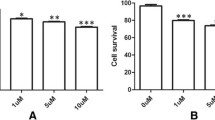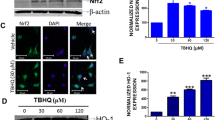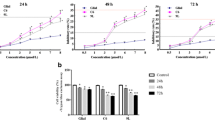Abstract
We have previously reported that arsenic trioxide (ATO) could inhibit glioma growth both in vitro and in vivo, and demonstrated its potent therapeutic effects on gliomas. In this study we showed that ATO induced cell damage and heme oxygenase-1 (HO-1) expression in glioma cells via ROS generation. HO-1 inducer clearly protected from ATO-induced cell death and ROS generation, and HO-1 inhibitor led to a significant increase in cell death and ROS generation induced by ATO. In addition, knockdown of nuclear factor (erythroid-derived 2)-like 2 (Nrf2) strongly inhibited HO-1 expression induced by ATO, and significantly enhanced ATO-induced oxidative damage. Our results demonstrated, for the first time, that HO-1 inhibition or Nrf2 knockdown significantly potentiated ATO’s effects on glioma cells. Considering that HO-1 is highly expressed in glioma tissues, administration of ATO in combination with either HO-1 inhibitor or Nrf2 knockdown may act as a new approach to the treatment of glioma.







Similar content being viewed by others
References
Berger F, Gay E, Pelletier L, Tropel P, Wion D (2004) Development of gliomas: potential role of asymmetrical cell division of neural stem cells. Lancet Oncol 5:511–514
Carpentier AF (2005) Neuro-oncology: the growing role of chemotherapy in glioma. Lancet Neurol. 4:4–5
Rego EM, He LZ, Warrell RP Jr, Wang ZG, Pandolfi PP (2000) Retinoic acid (RA) and As2O3 treatment in transgenic models of acute promyelocytic leukemia (APL) unravel the distinct nature of the leukemogenic process induced by the PML-RARalpha and PLZF-RARalpha oncoproteins. Proc Natl Acad Sci USA 97:10173–10178
Miller WH Jr, Schipper HM, Lee JS, Singer J, Waxman S (2002) Mechanisms of action of arsenic trioxide. Cancer Res 62:3893–3903
Maeda H, Hori S, Nishitoh H et al (2001) Tumor growth inhibition by arsenic trioxide (As2O3) in the orthotopic metastasis model of androgen-independent prostate cancer. Cancer Res 61:5432–5440
Um SJ, Lee SY, Kim EJ, Myoung J, Namkoong SE, Park JS (2002) Down-regulation of human papillomavirus E6/E7 oncogene by arsenic trioxide in cervical carcinoma cells. Cancer Lett 181:11–22
Zhao S, Zhang X, Zhang J et al (2008) Intravenous administration of arsenic trioxide encapsulated in liposomes inhibits the growth of C6 gliomas in rat brains. J Chemother 20:253–262
Zhao S, Zhang J, Zhang X, Dong X, Sun X (2008) Arsenic trioxide induces different gene expression profiles of genes related to growth and apoptosis in glioma cells dependent on the p53 status. Mol Biol Rep 35:421–429
Zhao S, Tsuchida T, Kawakami K, Shi C, Kawamoto K (2002) Effect of As2O3 on cell cycle progression and cyclins D1 and B1 expression in two glioblastoma cell lines differing in p53 status. Int J Oncol 21:49–55
Dilda PJ, Hogg PJ (2007) Arsenical-based cancer drugs. Cancer Treat Rev 33:542–564
Nguyen T, Yang CS, Pickett CB (2004) The pathways and molecular mechanisms regulating Nrf2 activation in response to chemical stress. Free Radic Biol Med 37:433–441
Nguyen T, Sherratt PJ, Nioi P, Yang CS, Pickett CB (2005) Nrf2 controls constitutive and inducible expression of ARE-driven genes through a dynamic pathway involving nucleocytoplasmic shuttling by Keap1. J Biol Chem 280:32485–32492
Konorev EA, Kotamraju S, Zhao H, Kalivendi S, Joseph J, Kalyanaraman B (2002) Paradoxical effects of metalloporphyrins on doxorubicin-induced apoptosis: scavenging of reactive oxygen species versus induction of heme oxygenase-1. Free Radic Biol Med 33:988
Chen TJ, Jeng JY, Lin CW, Wu CY, Chen YC (2006) Quercetin inhibition of ROS-dependent and -independent apoptosis in rat glioma C6 cells. Toxicology 223:113–126
Chen YC, Chow JM, Lin CW, Wu CY, Shen SC (2006) Baicalein inhibition of oxidative-stress-induced apoptosis via modulation of ERKs activation and induction of HO-1 gene expression in rat glioma cells C6. Toxicol Appl Pharmacol 216:263–273
Hara E, Takahashi K, Tominaga T et al (1996) Expression of heme oxygenase and inducible nitric oxide synthase mRNA in human brain tumors. Biochem Biophys Res Commun 224:153–158
Kim HR, Kim S, Kim EJ et al (2008) Suppression of Nrf2-driven heme oxygenase-1 enhances the chemosensitivity of lung cancer A549 cells toward cisplatin. Lung Cancer 60:47–56
Kensler TW, Wakabayashi N, Biswal S (2007) Cell survival responses to environmental stresses via the Keap1-Nrf2-ARE pathway. Annu Rev Pharmacol Toxicol 47:89–116
Ma Q, Kinneer K, Bi Y, Chan JY, Kan YW (2004) Induction of murine NAD(P)H:quinone oxidoreductase by 2,3,7,8-tetrachlorodibenzo-p-dioxin requires the CNC (cap ‘n’ collar) basic leucine zipper transcription factor Nrf2 (nuclear factor erythroid 2-related factor 2): cross-interaction between AhR (aryl hydrocarbon receptor) and Nrf2 signal transduction. Biochem J 377(Pt 1):205–213
Cho HY, Reddy SP, Debiase A, Yamamoto M, Kleeberger SR (2005) Gene expression profiling of NRF2-mediated protection against oxidative injury. Free Radic Biol Med 38:325–343
Arlt A, Bauer I, Schafmayer C et al (2009) Increased proteasome subunit protein expression and proteasome activity in colon cancer relate to an enhanced activation of nuclear factor E2-related factor 2 (Nrf2). Oncogene 28:3983–3996
Kwak MK, Kensler TW (2010) Targeting NRF2 signaling for cancer chemoprevention. Toxicol Appl Pharmacol 244:66–76
Li CQ, Kim MY, Godoy LC, Thiantanawat A, Trudel LJ, Wogan GN (2009) Nitric oxide activation of Keap1/Nrf2 signaling in human colon carcinoma cells. Proc Natl Acad Sci USA 106:14547–14551
Brouard S, Otterbein LE, Anrather J et al (2000) Carbon monoxide generated by heme oxygenase 1 suppresses endothelial cell apoptosis. J Exp Med 192:1015–1026
Jozkowicz A, Was H, Dulak J (2007) Heme oxygenase-1 in tumors: is it a false friend? Antioxid Redox Signal 9:2099–2117
Baranano DE, Rao M, Ferris CD, Snyder SH (2002) Biliverdin reductase: a major physiologic cytoprotectant. Proc Natl Acad Sci USA 99:16093–16098
Shen ZX, Chen GQ, Ni JH et al (1997) Use of arsenic trioxide (As2O3) in the treatment of acute promyelocytic leukemia (APL): II clinical efficacy and pharmacokinetics in relapsed patients. Blood 89:3354–3360
Wang W, Adachi M, Zhang R, Zhou J, Zhu D (2009) A novel combination therapy with arsenic trioxide and parthenolide against pancreatic cancer cells. Pancreas 38:e114–e123
Acknowledgments
This study was supported by the Special Prophase Project of National Basic Research Program of China (2009cb526404 to ZS), the National Natural Science Foundations of China (30901533 to LY and 30772239 to ZS), and the Foundation of the Harbin Science and Technology Committee (2007AA3CS083-2 to ZS).
Declaration
This study has no commercial interest. No financial or material support was received from any commercial source which is directly or indirectly related to the scientific work.
Author information
Authors and Affiliations
Corresponding author
Additional information
Yaohua Liu and Yuan Liang contributed equally to this work.
Rights and permissions
About this article
Cite this article
Liu, Y., Liang, Y., Zheng, T. et al. Inhibition of heme oxygenase-1 enhances anti-cancer effects of arsenic trioxide on glioma cells. J Neurooncol 104, 449–458 (2011). https://doi.org/10.1007/s11060-010-0513-1
Received:
Accepted:
Published:
Issue Date:
DOI: https://doi.org/10.1007/s11060-010-0513-1




